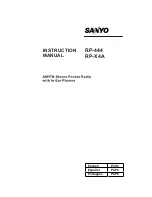
11
REV 75536i-20130729
ENGLISH
75536i
OPERATION
Do Not Overload Generator
Capacity
Follow these simple steps to calculate the running and
starting watts necessary for your purposes.
1. Select the electrical devices you plan on running at
the same time.
2. Total the running watts of these items. This is
the amount of power you need to keep your items
running.
3. Identify the highest starting wattage of all devices
identified in step 1. Add this number to the number
calculated in step 2. Surge wattage is the extra
burst of power needed to start some electric driven
equipment. Following the steps listed under “Power
Management” will guarantee that only one device
will be starting at a time.
Power Management
Use the following formula to convert voltage and
amperage to watts:
Volts x Amps = Watts
To prolong the life of your generator and attached
devices, follow these steps to add electrical load:
1. Start the generator with no electrical load attached.
2. Allow the engine to run for several minutes to
stabilize.
3. Plug in and turn on the first item. It is best to
attach the item with the largest load first.
4. Allow the engine to stabilize.
5. Plug in and turn on the next item.
6. Allow the engine to stabilize.
7. Repeat steps 5-6 for each additional item.
Never exceed the specified capacity when adding
loads to the generator.
NOTE
Overload Operation
The overload indicator light will turn on when the rated
load is exceeded. When the maximum load is reached,
the LED will blink and cut power to the receptacles. To
recover the power, shut down the engine, wait until the
light turns off and restart the generator.
Stopping the Engine
1. Turn off and unplug all electrical loads. Never start
or stop the generator with electrical devices plugged
in or turned on.
2. Let the generator run at no-load for several minutes
to stabilize internal temperatures of the engine and
generator.
3. Turn the Fuel Valve to the “OFF” position.
4. Let the engine run until fuel starvation has stopped
the engine. This usually takes a few minutes.
5. Turn the engine switch to the “Off” position.
Important: Always ensure that the Fuel Valve and the
Engine Switch are in the “OFF” position when the
engine is not in use.
If the engine will not be used for a period of two (2)
weeks or longer, please see the storage section for proper
engine and fuel storage.
NOTE
12V DC Outlet
1. Before connecting the battery charging cable to a
battery that is installed in a vehicle, disconnect the
vehicle battery ground cable from the negative (–)
battery terminal.
2. Plug the battery charging cable into the DC
receptacle of the generator.
3. Connect the red (+) battery charger lead to the red
(+) battery terminal.
4. Connect the black (–) battery charger lead to the
black (–) battery terminal.
5. Start the generator.
The 12V DC outlet is ONLY to be used with the supplied
12V battery charging cable. The DC output is unregulated
and will damage other 12V DC products. When using the
DC outlet, turn the Economy switch to the “OFF” position.
Be sure all electric devices including the lines and plug
connections are in good condition before connection to
the generator.
NOTE
Do not start the vehicle while the battery charging cable is
connected and the generator is running. It will not give the
battery a boost of power. The vehicle or the generator may
be damaged. Charge only vented wet lead acid batteries.
Other types of batteries may burst, causing personal injury
or damage.
CAUTION















































